Four months into our year-long lap of Australia, we hit the epic Gibb. Our family – two adults and four kids aged 3, 4, 6 and 8 – had already adventured through Cape York, the Savannah Way, the Red Centre, Kakadu National Park and more. But nothing had prepared us for two weeks on Gibb River Road, the one and only road through the heart of the Kimberley.
This 660 kilometre former cattle route strikes excitement and fear into the hearts of die-hard Aussie travellers. Lured by images of the spectacular Kimberley – despite warnings of caravan-destroying corrugations, tyre-shredding rocks, crocs and temperatures heading towards the 40’s – we decided to take the risk and tow our 6-metre caravan along the Gibb River Road.
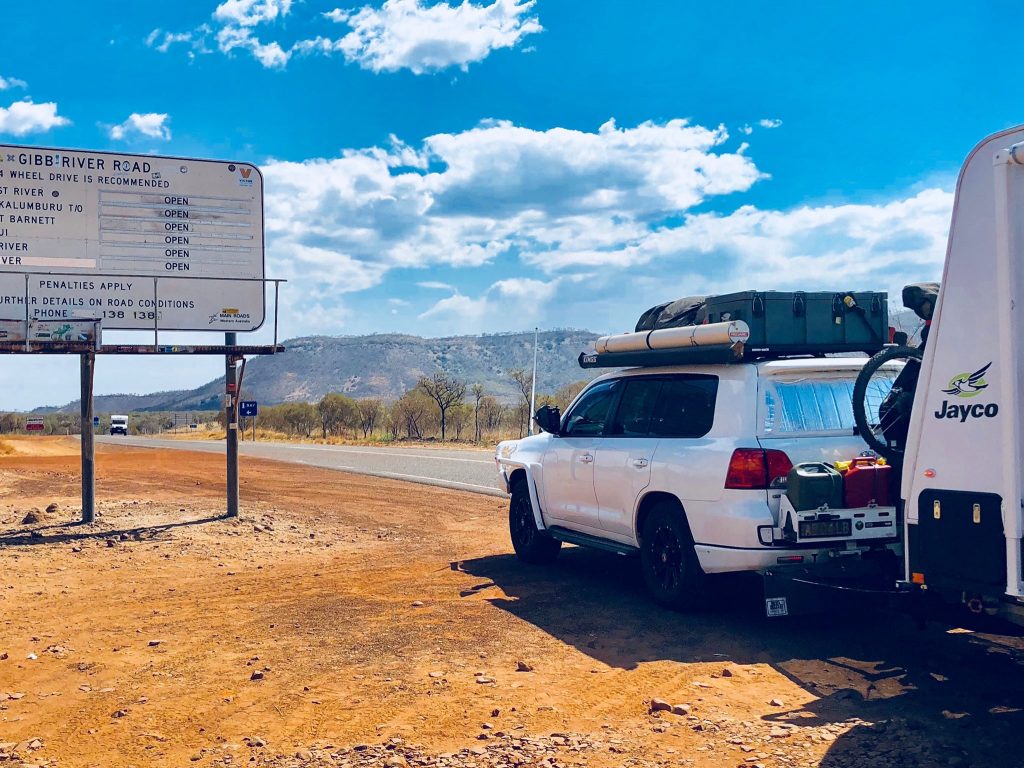
Savour the dust and drama of the Gibb River Road. Credit: Louise Ball
The Kimberley
The Kimberley did not disappoint. In fact, it is mind-blowingly spectacular. Billions of years of rock formation and erosion have created a web of spectacular gorges. It was these hidden playgrounds that won the hearts of our four children. Hours upon hours of corrugated dirt roads led us to these amazing natural wonders, where we hiked through narrow fissures to reach spectacular waterfalls, plunge pools, lush palms and greenery. We loved playing in waterfalls, scrambling over boulders to reach swimming spots we knew the crocodiles couldn’t get to and eating packed lunches under the shady palms.
The atmosphere of stations and campgrounds was equally memorable. The Kimberley experience really kicks off at the 283,000-hectare El Questro wilderness park, two hours south-west of Kununurra. Being the most accessible, this park is also the busiest. Still, it definitely retains a remote feel and provides adventure options such as helicopter flights, horserides, 4WD tours, live entertainment, and accommodation ranging from campsites to luxury lodges. We spent three days at a quiet campsite near the river, exploring the spectacular Emma Gorge, Zebedee Springs, Ord River 4WD track and escarpment lookout.
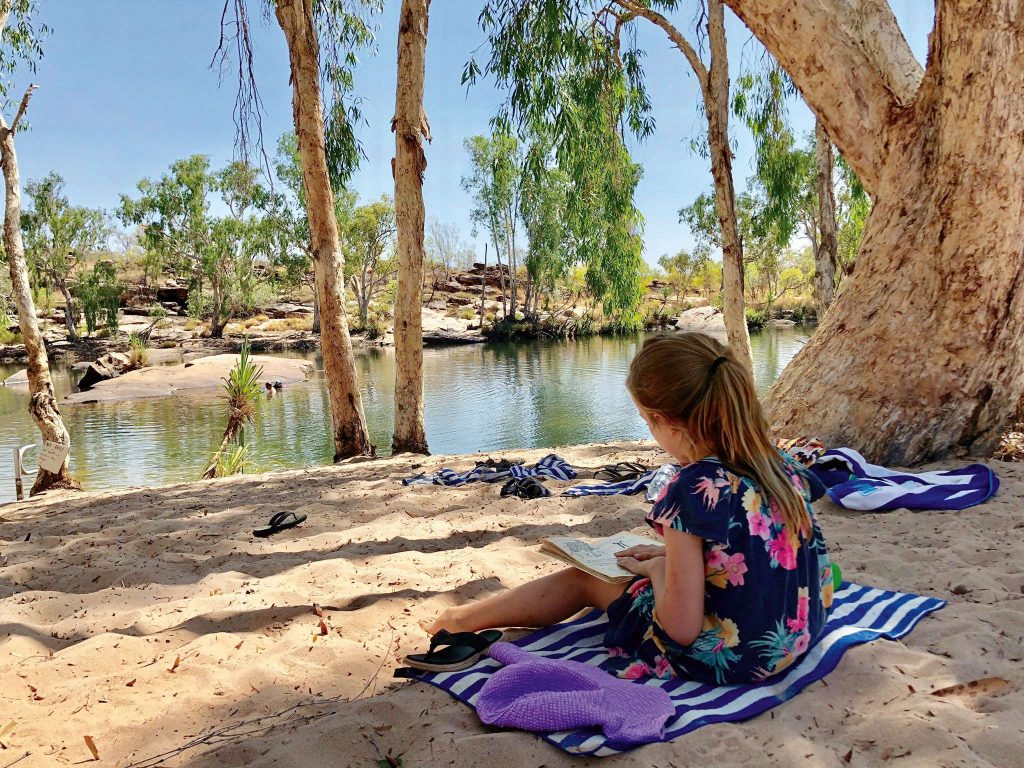
Relax with a book in the shade. Credit: Louise Ball
Home Valley Station
Home Valley Station, another two hours west along the Gibb, was our next stopover. The kids were thrilled when we rolled into camp and they spotted a swimming pool. Mornings were spent exploring rivers and gorges and lunchtimes back in the cool of the caravan. By mid-afternoon we headed to the pool to meet up with the friends we had met at El Questro. By the time happy hour rolled around, the bar was in full swing, complete with live entertainment and a big screen telecasting live sports games.
We finally said goodbye to our friends on the sixth day of our Gibb River adventure, hitching up the caravan to head to the infamous Ord River crossing. By now it was October and water levels had dropped enough so that the water only came up to our side-steps. Easy… until we encountered the sharp rocks on the other side! Suddenly our tyre pressure management system alarm started screaming. One of our caravan tyres had been sliced open by a rock. We’d expected this from the Gibb. The hour it took to change the tyre in 38-degree heat in the middle of a red dirt road, not far from a river full of saltwater crocodiles, was all part of the adventure!
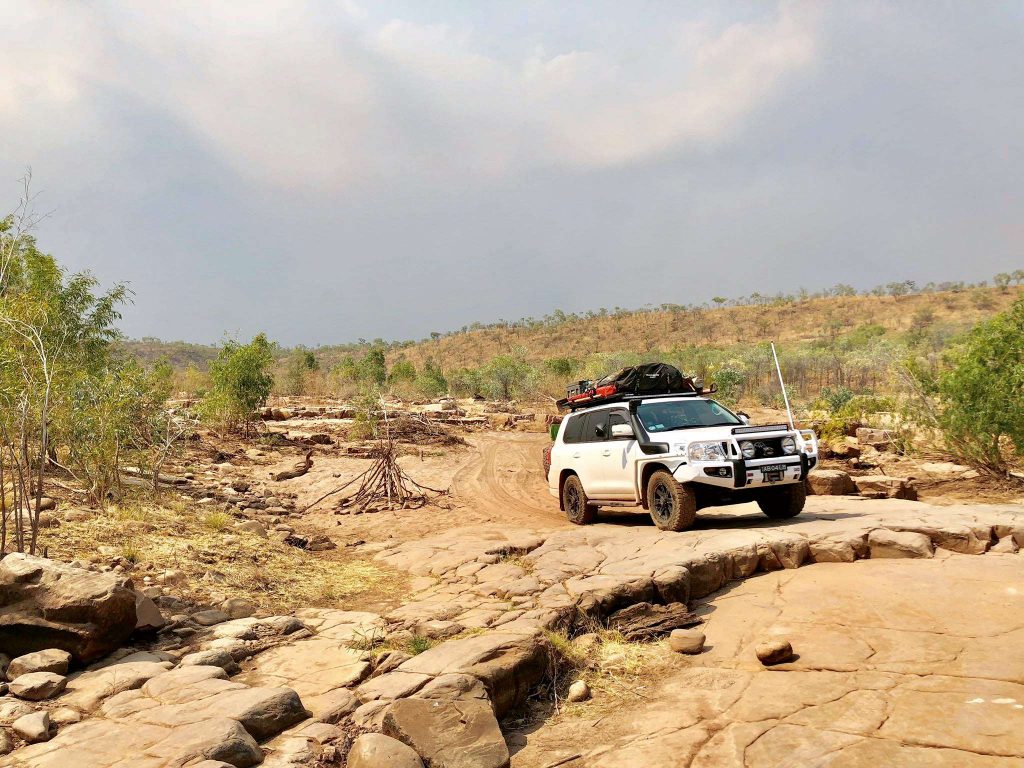
The driving is some of Australia’s hardest on the Gibb River Road. Credit: Louise Ball
Mitchell Falls and Manning Gorge
With a repaired tyre and bellies full of scones (thanks to a stop-in at Ellenbrae cattle station), we headed out onto the Gibb once again. A few hours down the road, we had the option of turning north and spending a few days exploring Mitchell Falls and Kalumburu. We decided to leave this detour for next time. By October, Mitchell Falls had almost stopped flowing and the difficult five- to six-hour return walk would have been too much for the kids. Kalumburu is famous for its picturesque fishing, but the resident crocodile was making it hard for families to cool off at the beach.
Instead, we headed straight to Manning Gorge. In our opinion, it’s the most beautiful campground on the Gibb. This is largely due to the spectacular waterhole with large sandy banks, surrounded by tall shady trees and a rope swing for the kids. The nearby Mt Barnett Roadhouse supplies fuel, bottled water and basic long-life supplies.
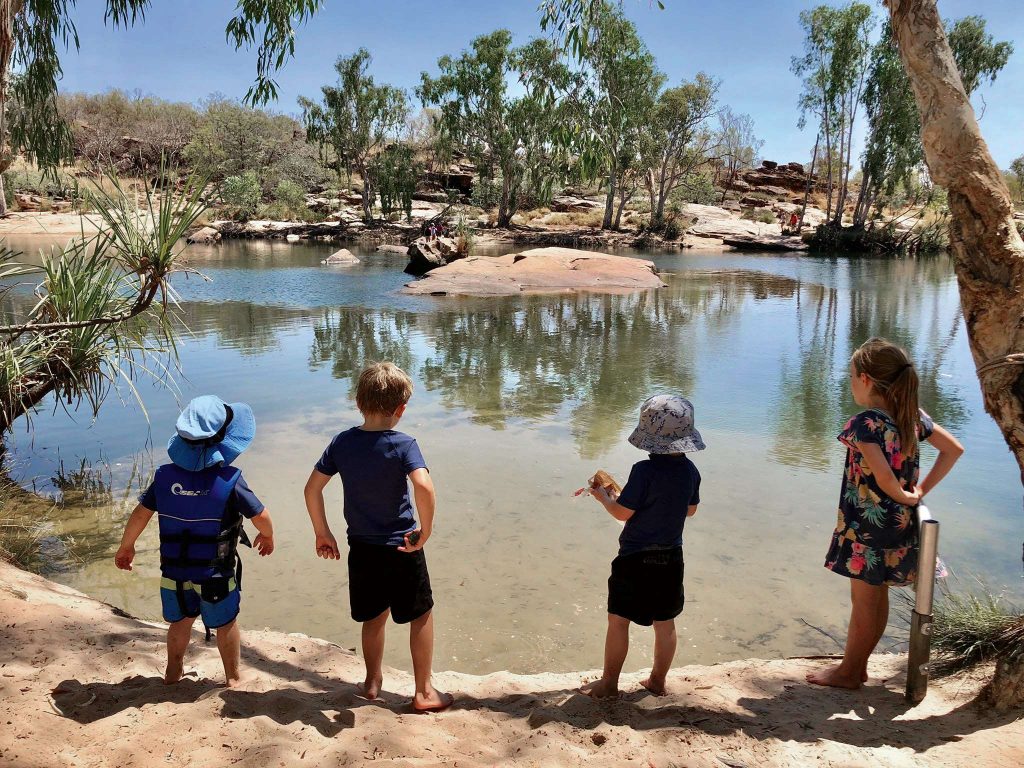
There are plenty of swimming spots, but you must watch for crocs. Credit: Louise Ball
Windjana Gorge
Down the western half of the Gibb is Windjana Gorge. It is famous for the scores of freshwater crocodiles sunbaking on the river shores. The kids loved running along the path beside the sandstone caves and climbing through the tunnels and archways. Cattle grazed between the campsites and the camp manager came around each afternoon to collect the fees. From here, we took a daytrip to Tunnel Creek. The 750-metre tunnel was worn through the Napier Range by an ancient creek. We picked the perfect day for it. It was 45 degrees outside, but at least 10 degrees cooler descending into the caverns. Prepared with head torches and water shoes, we waded through pools. Keeping an eye out for freshwater crocs, we passed stalactites, waterfalls, coloured rock and bats.
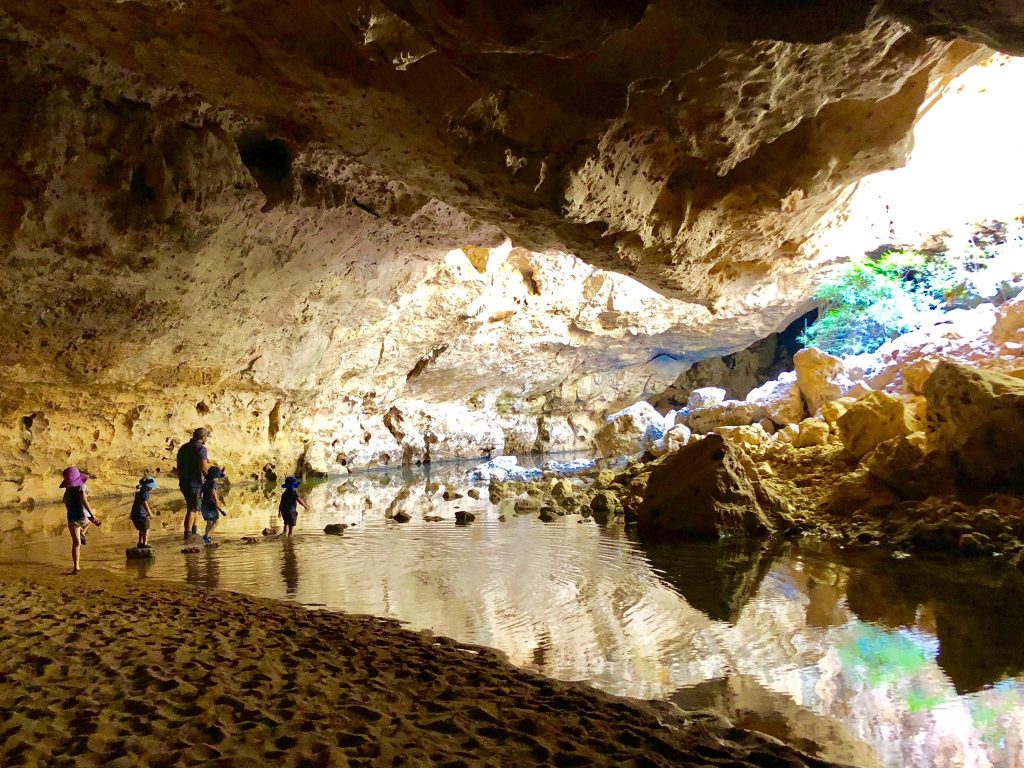
Cool dark caverns offer welcome relief from high temperatures. Credit: Louise Ball
There is nothing that can truly prepare you for the Kimberley, but it is well worth the effort. Memories of its remoteness, beauty, heat, crocodiles and the characters who live there will stay with you forever.
Our Top Tips:
The motto of ‘Be prepared’ is key in this remote wilderness.
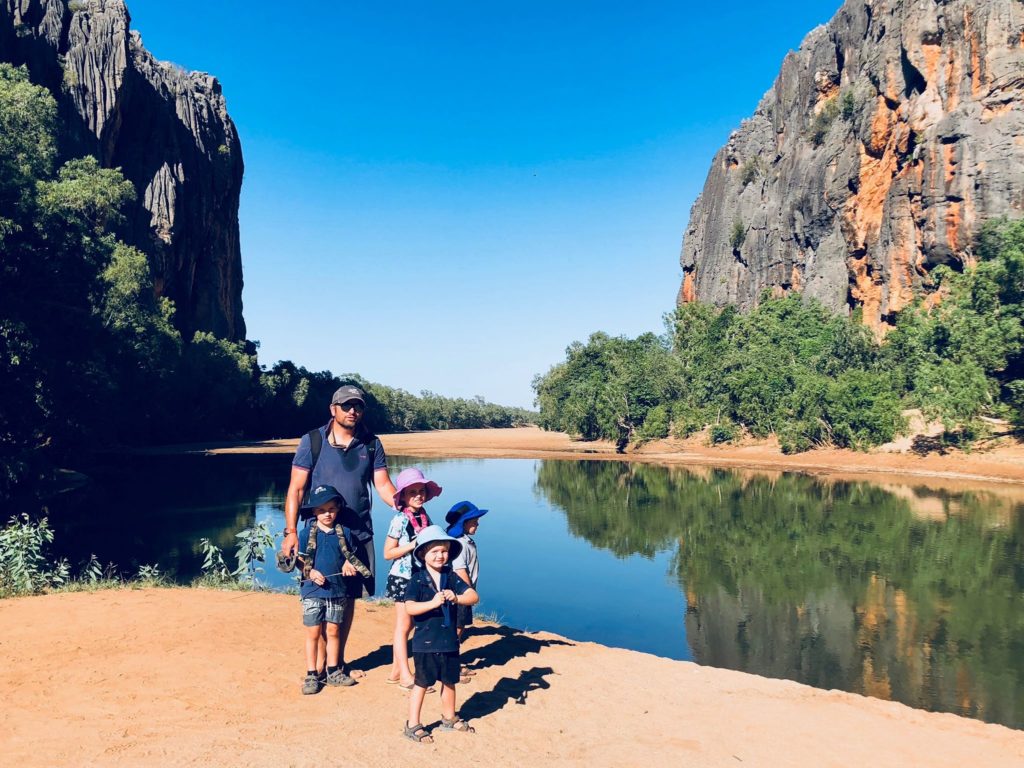
There are plenty of photo ops in the spectacular Kimberley. Credit: Louise Ball
Food. Don’t expect to find fresh milk, bread, fruit, vegetables or meat, so bring in everything you plan to eat. A few stations and roadhouses offer counter meals, but if a truck is delayed they sometimes run short. We were grateful for our caravan fridge and 200L of onboard water tanks.
Clothing. All you’ll need is swimmers, thongs, shorts and tops. If you plan to hike, add a long-sleeve sun shirt, a shady hat and a pair of sturdy walking sandals that can be worn through water. The main campgrounds have washing machines, so just pack three to four sets of clothes per person.
Backpacks. A good backpack is essential for stashing water bottles, snacks, sunscreen and fly repellent. Our kids loved wearing their own backpacks with in-built water bladders and pockets for their apples and muesli bars.
Carrier. If you have a young child, consider packing a small toddler carrier that fits in your backpack. Our 3-year-old loved to start walks by himself. But when his little legs inevitably got tired, we could pop on the carrier and comfortably tow him the rest of the way.
Safety gear. There is no mobile reception on the Gibb, so for safety we carried both a satellite phone and an emergency position indicating radio beacon. We also carried extensive first-aid and snake-bite kits. Ensure you stock up on any medications before you head out. There are no doctors or chemists out here.
Car spares. In preparation for the trip, we fitted a long-range fuel tank, a tyre-pressure monitoring system, a stone stomper and a good spare tyre (take two if you can fit them!). We were already set up with good suspension and a raft of 4WD gear.
When to go
Early June is best. The stations and campgrounds open during the dry season (May to October). If you travel too early in the season, some roads may be flooded and gorges inaccessible. Late in the season, the waterfalls dry up, gorges close due to fires and the heat becomes unbearable. If you travel in school holidays and peak times, book ahead for the likes of El Questro, Home Valley Station and Manning River Campground.
Most travellers spend two to four weeks doing the Gibb River Road. Ideally, plan a day to travel between each camp and spend a few days in each place.
READ MORE:
Why your family needs to do the epic Aussie road trip
Great NT wildlife adventures for kids
This story first appeared in Family Travel magazine. To subscribe or read back issues of the magazine, click here.
